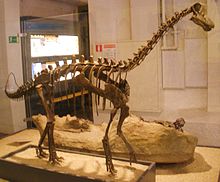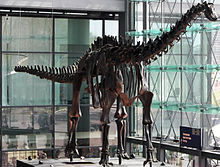梁龙科
| 梁龙科 | |
|---|---|

| |
| 梁龙科的头部 | |
| 科学分类 | |
| 界: | 动物界 Animalia |
| 门: | 脊索动物门 Chordata |
| 纲: | 蜥形纲 Sauropsida |
| 总目: | 恐龙总目 Dinosauria |
| 目: | 蜥臀目 Saurischia |
| 亚目: | †蜥脚形亚目 Sauropodomorpha |
| 下目: | †蜥脚下目 Sauropoda |
| 演化支: | †沉重龙类 Gravisauria |
| 演化支: | †真蜥脚类 Eusauropoda |
| 演化支: | †新蜥脚类 Neosauropoda |
| 总科: | †梁龙总科 Diplodocoidea |
| 演化支: | †梁龙形类 Diplodocimorpha |
| 演化支: | †鞭尾类 Flagellicaudata |
| 科: | †梁龙科 Diplodocidae Marsh, 1884 |
| 模式种 | |
| †长梁龙 Diplodocus longus Marsh, 1878
| |
| 演化支 | |
| 异名 | |
梁龙科(学名:Diplodocidae)是群蜥脚下目恐龙,梁龙、迷惑龙、雷龙(雷龙和迷惑龙为同一亚科的不同属)都是属于梁龙科的恐龙。梁龙科中包括数种颈部、尾部极长的恐龙,例如梁龙和超龙,体型可长达34米[1]。而只有发现一节脊椎的双腔龙,被估计身长可达40到60米。
叙述
[编辑]

与体型同样巨大的泰坦巨龙科与腕龙科相比,梁龙科恐龙的身体较为修长,并拥有短腿,让牠们看起来像是巨大恐龙中的腊肠犬。而牠们的后肢长于前肢,让牠们的颈部之后形成一个明显的倾斜面。在90年代早期,发现了一种梁龙科恐龙,背部拥有一排角质(非骨质)构成的尖刺。长颈和长尾是其特征,如鞭的尾巴可以保护身体。因为牠们的真皮组织很少保存于化石记录中,所以目前并不清楚牠们的皮肤覆盖物,但帆状物可能是梁龙科的普遍特征。
梁龙的手脚指各有五根,在后脚的三根和前脚的一根中,有锐爪。腰和背部下方和尾椎骨上均有长刺,此处的背肌端很结实。
梁龙科恐龙的颈部非常长,根据最近的电脑模拟,牠们可能无法如同其他蜥脚下目一样高举牠们的颈部。牠们可能使用颈部来以大范围区域的植物为食,而非以高层植物为食。牠们可能颈部来钻入密集的针叶林之中,或者举到沼泽地面上。
如同其他蜥脚类恐龙,梁龙科恐龙的头部很小,而鼻管孔则位在头颅骨的顶部;然而,牠们的鼻孔可能位在口鼻部前端。牠们的牙齿仅位于嘴部前方,外型为铅笔状或钉状,草食性。牠们可能用牙齿来切断植物,没有经过咀嚼过程,而依靠胃石来磨碎植物纤维;类似现代的鸟类。
梁龙科恐龙拥有类似鞭状的长尾巴,尾巴基部厚,但尾巴逐渐变薄,末端非常细。尾椎骨下宛如枕木的骨骼,是为了要保护拖在地面的尾巴,因此命名为“两根柱梁”。经电脑模拟可知,梁龙类可轻易地挥动尾巴,如同长鞭。尾巴的挥动可产生音爆,产生约200分贝的巨响;这个动作可能作为求偶时的展示,或是用来吓退攻击牠们的掠食性动物。有些证据可支持这个理论,在些梁龙科化石的尾端脊椎骨上发现了愈合与损伤的痕迹,这可能是尾巴遭到大力撞击的病状,支持这项推测。
皮肤
[编辑]目前很少发现梁龙科的皮肤痕迹化石。在1993年,斯特芬·柯瑞克斯(Stephen Czerkas)表示有一个梁龙科化石曾发现尾巴末端的皮肤痕迹[2]。这个皮肤痕迹有一连串圆锥状长刺,沿者尾巴中线而排列,较大尾椎有较大型的长刺。柯瑞克斯推测,这排长刺沿者颈部、背部、直到尾巴末端[3]。
分类
[编辑]
这群长颈部、鞭状尾的蜥脚龙类恐龙,在被命名梁龙科之前,曾有两个科级分类名称,但梁龙科是目前的有效名称。在1878年,爱德华·德林克·科普(Edward Drinker Cope)命名双腔龙时,建立双腔龙科(Amphicoeliidae),以包含双腔龙属。当时古生物学界里,多将双腔龙归类于梁龙科[6]但在1899年后,科学文献、研究没有普遍引用、使用双腔龙科这个分类名称。根据《国际动物命名法规》,这个分类名称已有50年以上没有被多个科学文献引用,因此双腔龙科是个遗忘名(nomen oblitum)。
在1877年,奥塞内尔·查利斯·马什(Othniel Charles Marsh)命名载域龙时,也建立载域龙科(Atlantosauridae),以包含载域龙属。20世纪初,有古生物学家提出载域龙科具有学理有效性,比双腔龙科、梁龙科还有优先权[7]。在1970年代,也有古生物学家认为载域龙科是有效的分类单元,甚至单独建立载域龙亚科(Atlantosaurinae)[8] 。在1991年,乔治·奥利舍夫斯基(George Olshevsky)主张载域龙科也是个遗忘名[9]。
梁龙科各属的互相关系,目前还没有定论。根据2008年的一项研究,提出春雷龙、超龙是迷惑龙的近亲,都属于迷惑龙亚科[5]。而在2011年的研究,则认为超龙是梁龙的近亲,跟迷惑龙的关系较远;而春雷龙是种原始叉龙科动物[4]。
双腔龙可能也是梁龙科的物种,牠们的分类有些可疑点,但牠们的颈部相当长[6];因此常被分类为梁龙超科里的一个未分类属。目前仍没有足够发现可将双腔龙更正确的分类。近年研究多将双腔龙视为原始梁龙超科动物,而不属于梁龙科[4]。
参考文献
[编辑]- ^ Lovelace, David M.; Hartman, Scott A.; and Wahl, William R. Morphology of a specimen of Supersaurus (Dinosauria, Sauropoda) from the Morrison Formation of Wyoming, and a re-evaluation of diplodocid phylogeny. Arquivos do Museu Nacional. 2007, 65 (4): 527–544.
- ^ Czerkas, S.A. (1993). "The new look of sauropods." Journal of Vertebrate Paleontology, 13: 26A.
- ^ Czerkas, S.A. (1993). "Discovery of dermal spines reveals a new look for sauropod dinosaurs." Geology, 20: 1068–1070.
- ^ 4.0 4.1 4.2 Whitlock, J.A. (2011). "A phylogenetic analysis of Diplodocoidea (Saurischia: Sauropoda)." Zoological Journal of the Linnean Society, Article first published online: 12 Jan 2011. doi:10.1111/j.1096-3642.2010.00665.x
- ^ 5.0 5.1 Lovelace, David M.; Hartman, Scott A.; and Wahl, William R. Morphology of a specimen of Supersaurus (Dinosauria, Sauropoda) from the Morrison Formation of Wyoming, and a re-evaluation of diplodocid phylogeny. Arquivos do Museu Nacional. 2008, 65 (4): 527–544.
- ^ 6.0 6.1 Carpenter, K. (2006). "Biggest of the big: a critical re-evaluation of the mega-sauropod Amphicoelias fragillimus." In Foster, J.R. and Lucas, S.G., eds., 2006, Paleontology and Geology of the Upper Jurassic Morrison Formation. New Mexico Museum of Natural History and Science Bulletin 36: 131-138.存档副本 (PDF). [2008-01-08]. (原始内容 (PDF)存档于2007-12-02).
- ^ Hay, O.P. (1902). "Bibliography and Catalogue of the Fossil Vertebrata of North America." Bulletin of the United States Geological Survey, 179: 1-868.
- ^ Nowinski, A. (1971). "Nemegtosaurus mongoliensis n. gen., n. sp. (Sauropoda) from the uppermost Cretaceous of Mongolia." Palaeontologia Polonica, 25: 57-8.
- ^ Olshevsky, G. (1991). "A Revision of the Parainfraclass Archosauria Cope, 1869, Excluding the Advanced Crocodylia." Mesozoic Meanderings, 2.
外部链接
[编辑]- Cracking the whip (页面存档备份,存于互联网档案馆), from the NewScientist.
- Ivan Peterson's Whips and Dinosaur Tails (页面存档备份,存于互联网档案馆).
- Skeletal restorations of several diplodocids, from Scott Hartman's Skeletal Drawing website.
|
Text is available under the CC BY-SA 4.0 license; additional terms may apply.
Images, videos and audio are available under their respective licenses.













